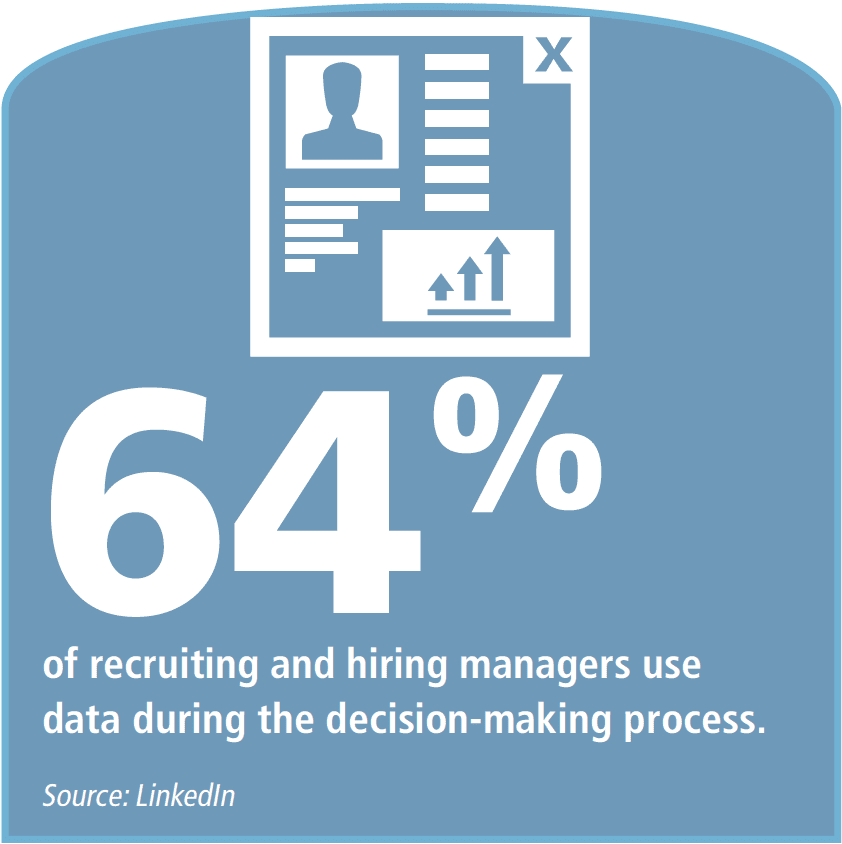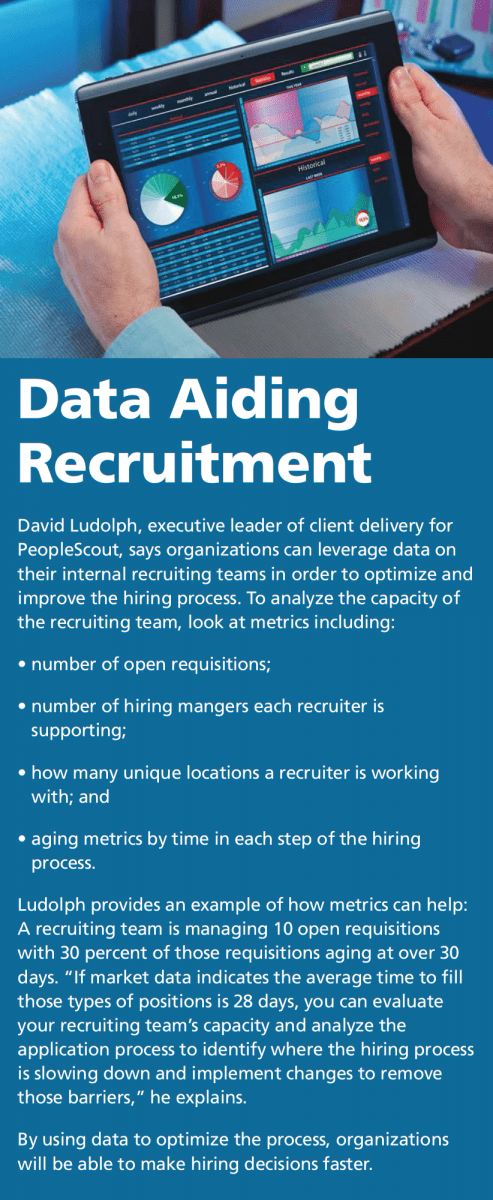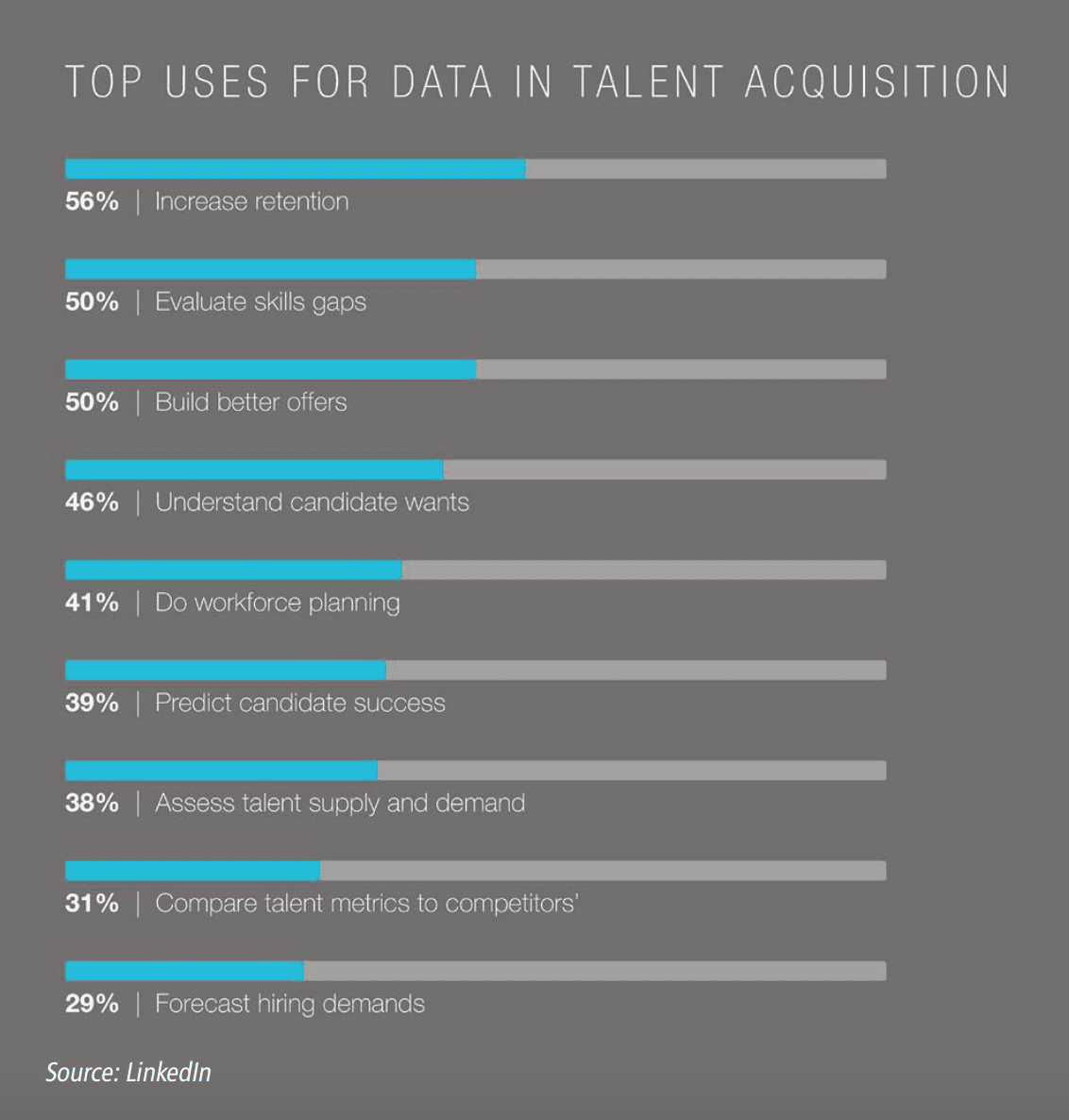Analytics have the power to help HR solve their toughest challenges.
By Debbie Bolla
There is definitely strength in numbers when it comes to understanding the workforce. Data has the power to determine the best sources of hire, underlying reasons for attrition, strategies to retain workers, and ways to optimize workforce planning. LinkedIn’s Global Recruiting Trends Report finds that 64 percent of recruiting and hiring managers use data during the decision-making process. With so much workforce data out there, where should HR begin?
 “To really get the most out of your data, you need to start with the questions you need answered,” recommends Marissa Geist, executive vice president and managing director of the Americas for Cielo. “Where are you challenged? Are you struggling to find people to apply? Can you not retain candidates? Listen for the noisiest parts of the current process and you will hear them -then figure out what to solve.”
“To really get the most out of your data, you need to start with the questions you need answered,” recommends Marissa Geist, executive vice president and managing director of the Americas for Cielo. “Where are you challenged? Are you struggling to find people to apply? Can you not retain candidates? Listen for the noisiest parts of the current process and you will hear them -then figure out what to solve.”
With questions in hand, Geist says the most common core data points that can help identify solutions include:
- Industry benchmarks. Obtaining market data based on talent and HR performance by industry sector allows organizations to set core benchmarks. Keep the same ones in place for 12 months to maintain a clean analysis.
- Salary data. External compensation data is typically available in mature markets. If the market is less established, organizations can leverage historical data. Find at least two data points to compare for compensation practices.
- Performance data. Organizations should track 90-day turnover and retention by job title, location, and skill set to establish a baseline.
- Hiring-process performance. Funnel metrics are basic, but often elusive. Conversion numbers through the funnel, such as interviews to hire, and attraction statistics, such as recruitment marketing dollars spent per role, help monitor effectiveness. Time is also a factor, so tracking the speed of each step can show opportunities for improvement.
Looking at the numbers to see what they reveal about speed is key to Val Egan’s approach to data analysis. The senior director of talent acquisition for the Girl Scouts of the USA leverages metrics from their applicant tracking system (ATS) to measure performance. “One of our most important KPIs is the time-to-fill metric,” she says. “We use our applicant tracking system to record our intake meeting dates, posting dates of positions, and our verbal acceptances in order to track the time to fill of each position.”
Egan also says that candidates funnel directly through the ATS, which allows the organization to capture source of hire.
For Kris Dunn, chief human resources officer of Kinetix, getting the most out of performance data is high on the priority list but also a challenge. “The holy grail, of course, is linking performance data with new hires, then understanding which candidate profiles and sources deliver the best match,” he says. “Unfortunately, for most organizations, clean performance data is difficult to find.”
Dunn has found success by keeping things simple and using data to pinpoint which hiring managers, functions, and locations perform the best when it comes to hiring. “Meaning they have the lowest churn with the perception of above average performance,” he explains further.

Analyzing attrition data provides organizations many levels of value, from identifying concrete periods of time when employees tend to leave positions to learning what’s driving them away.
“We can understand attrition, where it is happening, when in the employee lifecycle it occurs, and potentially, if employees give good reasons in an exit interview, why it is happening,” says Cielo’s Geist. “Data adds important insight into the situation.”
The Girl Scouts of the USA review specific analytics to determine turnover trends. “We look at many data points in regard to an employee who leaves us,” explains Egan. “This includes level, job title, department, manager, and length of service. Then we look for trends.”
The TA team takes it one step further by matching attrition data with feedback from exit interviews, which is housed in a separate system. Marrying this information reveals if a common reason for the departure exists, like challenging relationships with a manager, allowing action to be taken.
“In some instances, after reviewing data from the attrition analytics, coaching was provided to managers or changes in reporting structures were made,” Egan explains.
As for turnover based on tenure, David Ludolph, executive leader of client delivery for PeopleScout, recommends analyzing if employees are consistently leaving the organization after a certain amount of time in a position. “We worked with a client who believed their highest turnover point was at the 60-day mark. However, after analyzing turnover data, we discovered that average turnover happened at just over two years,” he explains.
With this insight, the organization began building retention plans to target the first risk point of turnover in order to get ahead of losing employees. Checkpoints at key times help ongoing communication and build a greater chance for retention.
Timing can also be a factor. Geist says it’s beneficial to compare turnover patterns with business cycles. For example, an organization may experience high turnover among millennials in the spring months. “Do you pay annual bonuses in spring and suffer attrition in the three to five weeks following? Maybe it’s time to move to quarterly bonuses,” she says. A simple business decision driven by data can make a big difference.
There are also technology solutions on the market that leverage algorithms to understand employee patterns and decode attrition. Jason Roberts, global head of technology and analytics for Randstad Sourceright, says, “Algorithms can assist by adding innumerable variables that may impact attrition based on a machine learning model. Where a basic model might show a time-based linear prediction, the algorithmic model can add layers of complexity to build a more accurate view of when and why employees choose to leave.”
Roberts says HiQ is a platform that examines both internal and external triggers of employee behavior that lead to turnover. Internal impacts include team member changes and the amount of time since the last pay increase, whereas social media activity is an external factor. The technology can even provide insight from stock market activity.
“The platform even predicted that in the Silicon Valley, where stock options are an important part of compensation packages, an employer’s stock price versus its competitors has a correlation with attrition,” he explains.
Getting More
“Today, we are in the early stages of data -often predicting what will happen. The next step is to let the existing systems start making recommendations based on the data they are collecting. As these systems begin to take corrective actions when risks occur, the data evolution will move from predictive to prescriptive, and ultimately to cognitive systems,” says Roberts.

Improving access to data will be critical to HR’s future use. LinkedIn’s Global Recruiting Trends study found that 20 percent of respondents report being unaware of where to find the right data and 14 percent are not sure how to use it. “Understanding attrition, skill gaps, compensation, and other measurable components is limited to what is captured within internal systems,” says Ed Ryabovsky, head of talent acquisition for The Linde Group. “It is crucial to understand and interpret the bigger picture, external climate, generational trends, legislation, economic factors, political framework, and shifts in consumer needs.”
Connecting the dots between systems also impacts data’s potential. For example, Egan says the Girl Scouts of the USA is looking to integrate their “Talent Inventory” system with their ATS in order to increase internal mobility. “This ‘Talent Inventory’ is critical because it tracks and stores the skill sets of our current talent and this repository can help us to fill any gaps and increase the number of candidates with in-demand qualifications internally,” she explains. “This also leads to higher employee engagement. In the future, we are hoping to house all this data in the same place.”
Marrying internal data with external benchmarks helps provide a holistic view of organizational processes. “In order to fully evolve into a mature people analytics organization, it becomes imperative that external environment data is utilized in concert with existing data in the ATS and HRMS,” says Ryabovsky.














